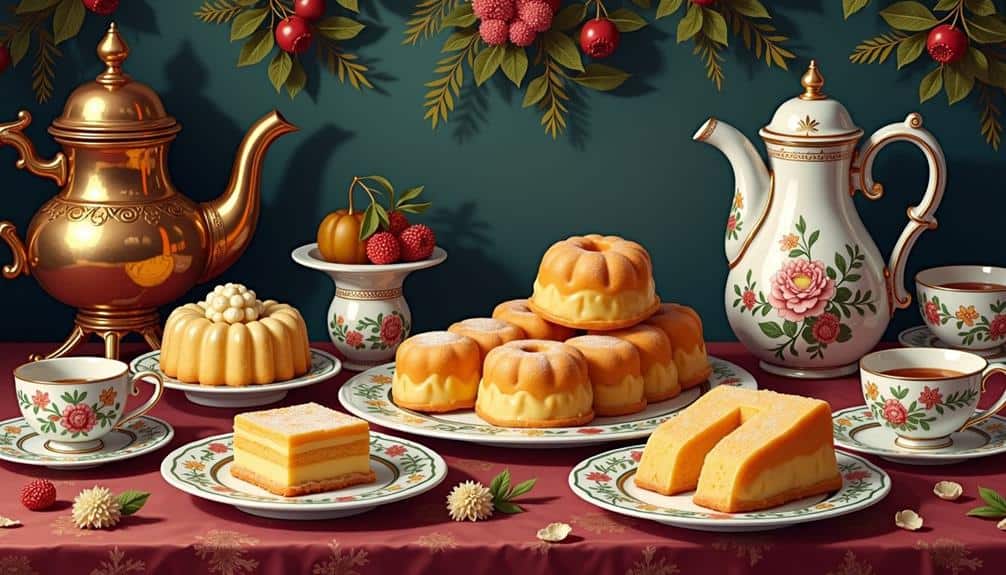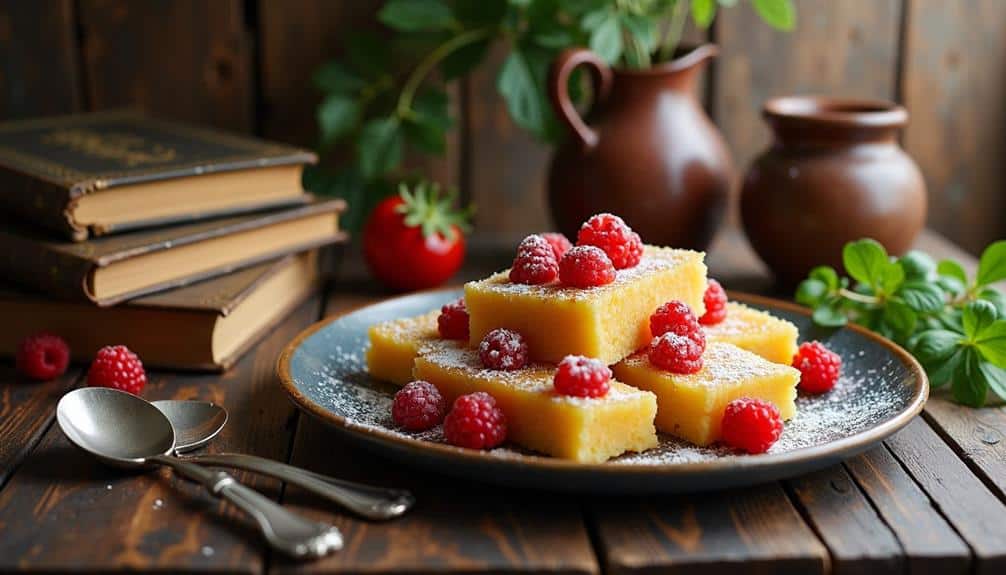When you think of traditional Russian desserts, Ptichye Moloko, or “bird’s milk,” probably comes to mind. This intriguing treat traces its origins back to ancient Slavic mythology, where it symbolized something rare and precious. Over time, it evolved, influenced by 18th-century French culinary traditions, and became a status symbol during the Soviet era. But what exactly makes Ptichye Moloko so special and how did it manage to capture the hearts of an entire nation? As you explore further, you’ll uncover rich layers of history, culture, and symbolism that continue to make this dessert a beloved staple in Russian heritage.
Origins of Ptichye Moloko

Ptichye Moloko, which translates to “bird’s milk,” has its origins deeply rooted in Eastern European culinary traditions, particularly in Russia. You’ll find that the term “bird’s milk” has been part of folklore for centuries, symbolizing something rare and unattainable. This dessert, however, made the unattainable quite tangible and delectable.
Historically, Ptichye Moloko’s inception draws from French culinary influences that entered Russia during the 18th century. French chefs, employed by Russian nobility, introduced creamy and mousse-like desserts that became the foundation for Ptichye Moloko. Initially, it was a custard-based dessert, appreciated for its light and airy texture, which seemed almost otherworldly.
As you trace its development through the 19th century, you’ll notice variations emerging. Some versions incorporated gelatin to create a semi-solid form, while others experimented with chocolate coatings. These dessert variations reflected regional tastes and available ingredients, evolving from a simple custard to more complex, layered creations.
Understanding Ptichye Moloko’s origins helps you appreciate its cultural significance. It’s more than just a dessert; it’s a sweet representation of the blending of culinary traditions and historical influences that have shaped Russian cuisine over centuries.
Evolution in Soviet Era
During the Soviet era, the evolution of Ptichye Moloko took on new dimensions as it adapted to the constraints and innovations of the time. With limited access to luxury ingredients, Soviet innovations played an essential role in reshaping this beloved dessert.
Initially, Ptichye Moloko was a luxury item, but Soviet citizens, driven by dessert nostalgia, found ingenious ways to recreate it using available resources.
In 1967, a significant milestone occurred when the Rot Front Confectionery Factory in Moscow developed a mass-producible version of Ptichye Moloko in candy form. This adaptation made the dessert more accessible to the general populace.
Later, in 1968, the Prague Restaurant in Moscow introduced Ptichye Moloko as a cake, further diversifying its forms and boosting its popularity.
Throughout the Soviet era, Ptichye Moloko became a symbol of ingenuity and resilience. You’d find families cherishing this dessert during festive occasions, reinforcing its cultural significance.
The dessert’s evolution during this period mirrors the Soviet spirit of making the most out of limited resources, all while preserving a sense of tradition and comfort.
Ingredients and Preparation

To create Ptichye Moloko, you’ll need a few key ingredients that are both simple and fundamental to its unique texture and flavor. Start with eggs, sugar, flour, butter, milk, and gelatin. These ingredients are essential for achieving the dessert’s distinctive flavor profile and texture contrast.
Begin by separating the egg whites and yolks. Whip the egg whites until they form stiff peaks, incorporating sugar gradually to create a meringue. This step is vital for the airy, mousse-like consistency that characterizes Ptichye Moloko.
In a separate bowl, mix the egg yolks with sugar and flour, then gradually add milk. Cook this mixture over medium heat, stirring constantly until it thickens into a custard.
Next, dissolve gelatin in water and let it bloom. Add the gelatin to the warm custard, ensuring it’s fully incorporated. Allow this mixture to cool slightly before folding in the meringue. The gelatin helps set the dessert, providing the necessary firmness while preserving the light, airy texture.
Pour the mixture into a mold and refrigerate until set. The result is a delicate dessert with a harmonious blend of flavors and a delightful texture contrast, embodying both Russian culinary tradition and innovation.
Ptichye Moloko in Popular Culture
After you’ve mastered the preparation of Ptichye Moloko, you might be curious about its cultural significance. This dessert has made notable appearances in Russian literature and cinema, reflecting its cherished status.
First, let’s explore literary references. Ptichye Moloko is featured in works by renowned Russian authors, symbolizing nostalgia and the comfort of home. For instance, in the 20th-century novel “The Twelve Chairs” by Ilf and Petrov, the dessert makes an appearance, evoking a sense of the Soviet-era culinary landscape. Such references underscore its role as a cultural touchstone, connecting readers to a shared heritage.
Moving to film appearances, Ptichye Moloko has been depicted in several Russian movies, often highlighting its luxurious and celebratory nature. In the 1984 Soviet film “Formula of Love,” the dessert serves as a metaphor for unattainable desires, adding layers to the narrative.
These cinematic moments not only celebrate the dessert’s aesthetic appeal but also cement its place in the collective memory.
Thus, Ptichye Moloko’s presence in literature and film underscores its enduring significance in Russian culture, resonating with themes of tradition and identity.
Regional Variations

Exploring the regional variations of Ptichye Moloko reveals a fascinating tapestry of adaptations and nuances across Russia’s vast landscape.
As you investigate Moscow variations, you’ll find that the dessert often features a refined mousse texture, thanks to the culinary innovations of Soviet-era chefs. It was in Moscow where the dessert gained its iconic status, blending French-inspired elegance with local flavors.
Moving eastward, Siberian adaptations highlight the region’s resourcefulness. Siberian recipes frequently incorporate local berries like cloudberries or lingonberries, adding a tangy twist to the traditional sweet. This adaptation not only reflects Siberia’s harsh climate but also its unique cultural palette.
In the Northern recipes, you’ll notice a reliance on dairy products, emblematic of the area’s rich pastoral traditions. Here, Ptichye Moloko might be made creamier, with a heavier use of butter and milk, resulting in a heartier dessert that mirrors the region’s robust culinary practices.
Finally, Southern twists to Ptichye Moloko incorporate more exotic ingredients like nuts and fruits, influenced by the diverse agricultural bounty of Russia’s south. These variations often feature a richer, more decadent flavor profile, showcasing the region’s warmer climate and fertile lands.
Each regional variation offers a unique insight into Russia’s rich culinary tapestry.
Modern-Day Celebrations
In modern-day Russia, Ptichye Moloko holds a cherished place in various celebrations and festive occasions. This dessert has shifted from a luxury item to a staple in holiday gatherings. If you attend a Russian New Year’s Eve party, you’ll often find Ptichye Moloko served alongside traditional dishes. It’s not just a treat; it embodies the festive traditions that bring families together.
During Christmas, Ptichye Moloko graces the dessert table, symbolizing the sweetness of the season. As you explore these celebrations, you’ll notice that the dessert is often presented in elaborate forms, sometimes even as beautifully decorated cakes. These modern presentations reflect the creativity and pride Russians take in their culinary heritage.
Birthdays and weddings also see Ptichye Moloko playing a key role. Its light, fluffy texture and delicate taste make it a favorite for large gatherings, where it’s shared among guests as a symbol of joy and prosperity.
Over the years, the dessert has maintained its cultural significance, evolving in its presentation but retaining its essence. In these modern celebrations, Ptichye Moloko continues to be a beloved icon of Russian festivity.
Culinary Techniques

Mastering the art of making Ptichye Moloko requires a blend of precise culinary techniques and a deep appreciation for Russian culture.
First, you’ll need to perfect your whipping techniques. Start by separating the egg whites and yolks, as the success of this dessert hinges on achieving the perfect meringue. Whip the egg whites until they form stiff peaks, guaranteeing they’re airy and light—this will give Ptichye Moloko its signature fluffy texture.
Next, you’ll create the custard base by gently heating the egg yolks with sugar and vanilla extract. This step is vital for the flavor enhancements that make this dessert so beloved. Combine the custard with the meringue, folding gently to maintain the airy consistency.
The final step involves preparing the gelatin mixture. Dissolve gelatin in warm water, then carefully mix it into the meringue-custard blend. This step not only solidifies the dessert but also preserves its delicate structure.
Pour the mixture into molds and refrigerate until set. Following these steps in chronological order will guarantee that you capture the essence of Ptichye Moloko, embodying both its historical roots and modern-day appeal.
Symbolism and Heritage
As you perfect the techniques required for Ptichye Moloko, it’s equally important to understand its cultural significance and heritage. This dessert, translating to “Bird’s Milk,” is steeped in history that dates back to ancient Slavic mythology. The term “Bird’s Milk” symbolized something so rare and precious that it was almost mythical, a reflection of the dessert’s unique place in Russian culture.
In the Soviet era, Ptichye Moloko gained prominence as a symbol of innovation and culinary excellence. It was officially patented in 1967 by the Rot Front confectionery factory, marking a significant moment in dessert heritage. The creation of this delightful confection involved sophisticated techniques, elevating it to a status symbol among Soviet sweets.
Understanding the cultural symbolism of Ptichye Moloko requires recognizing its role in celebrations and family gatherings. It represents a connection to heritage, embodying the warmth of shared moments and the richness of Russian culinary traditions.
Conclusion
You’ve now journeyed through the meticulous history of Ptichye Moloko, from its mythological origins to its Soviet-era evolution. You’ve explored its ingredients, preparation, and cultural symbolism. As you celebrate this cherished dessert today, you honor a rich heritage that spans centuries. Whether served at festive gatherings or featured in popular culture, Ptichye Moloko remains a symbol of Russian identity and sophistication. Embrace its legacy and savor its timeless charm.




